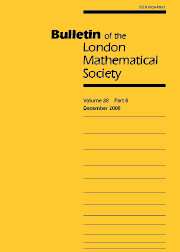GENERAL FORMS FOR MINIMAL SPECTRAL VALUES FOR A CLASS OF QUADRATIC PISOT NUMBERS
Published online by Cambridge University Press: 24 March 2003
Abstract
This paper studies the spectrum that results when all height one polynomials are evaluated at a Pisot number. This continues the research theme initiated by Erdős, Joó and Komornik in 1990. Of particular interest is the minimal non-zero value of this spectrum. Formally, this value is denoted as $l^1(q)$ , and this definition is extended to all height $m$ polynomials as \[ l^m(q):= \inf(\vert y\vert: y = \epsilon_0 + \epsilon_1 q^1 + \cdots + \epsilon_n q^n,\, \epsilon_i \in {\bb Z},\, \vert\epsilon_i\vert \leqslant m,\, y \ne 0). \] A recent result in 2000, of Komornik, Loreti and Pedicini gives a complete description of $l^m(q)$ when $q$ is the Golden ratio. This paper extends this result to include all unit quadratic Pisot numbers. A main theorem is as follows.
THEOREM. Let $q$ be a quadratic Pisot number that satisfies a polynomial of the form $p(x) = x^2 - ax \pm 1$ , with conjugate $r$ . Let $q$ have convergents $\{C_k/D_k\}$ and let $k$ be the maximal integer such that \[ \vert D_k r - C_k\vert \leqslant m \frac{1}{1-\vert r\vert}; \] then \[ l^m (q) = \vert D_k q - C_k \vert. \]
A value related to $l(q)$ is $a(q)$ , the minimal non-zero value when all ${\pm}1$ polynomials are evaluated at $q$ . Formally, this is \[ a(q) := \inf(\vert y\vert: y = \epsilon_0 + \epsilon_1 q^2 + \cdots + \epsilon_n q^n,\, \epsilon_i = {\pm} 1,\, y \ne 0). \] An open question concerning how often $a(q) = l(q)$ is also answered in this paper.
- Type
- NOTES AND PAPERS
- Information
- Copyright
- © The London Mathematical Society 2003
Footnotes
- 5
- Cited by


